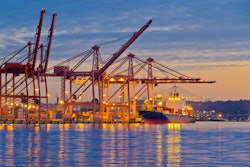
The ITS Logistics US Port/Rail Ramp Freight Index confirms that at a macro level, there have been no major changes since November’s index, according to ITS Logistics. The East and Gulf ports are seeing the normal December calm post-retail peak and prior to the Lunar New Year. And, the West Coast ports are still experiencing significant import volumes, which may result from some inventory being pulled forward to avoid possible tariffs and the expected International Longshoremen’s Association (ILA) strike activity in January 2025.
“The volumes coming from Asia on the trans-Pacific trade routes are not overwhelming the supply of capacity as spot rates at origin are not being pushed higher,” says Paul Brashier, VP of global supply chain for ITS Logistics. “For the time being, everything seems balanced. That said, if the US West Coast continues to be a release valve for a potential ILA strike supply chain disruption, there is a high risk that both West Coast Port and Rail operations could become overwhelmed.”
Key takeaways:
- Overall, the total October containerized imports volume across U.S. ports amounted to 2.25 million twenty-foot equivalent units through ports covered by the Global Port Tracker, which was off by 1.2% from September but ahead 9.3% from October of last year.
- Earlier this month, the ILA warned that another coastwide strike could occur when management from the United States Maritime Alliance (USMX) confirmed their intent to implement semi-automation. This directly contradicted the USMX opening statement, assuring the ILA that neither full nor semi-automation would be an option moving forward. Although both sides agreed to extend the current contract until Jan. 15, 2025, as of last week, neither party has chosen to pursue a new stance on implementing semi-automated rail-mounted gantry cranes.
- As of Nov. 12, it was reported that rail dwell times at the Port of Long Beach were at about four days, according to the port’s operations dashboard. The Port of Los Angeles’ on-dock average rail dwell times were close to eight days as of Nov. 13.
“While the industry awaits the latest update pertaining to the strike, professionals must also be aware that rail operations in Seattle and Los Angeles are continuing to struggle with interior point intermodal (IPI) freight and higher volumes of domestic peak retail freight,” adds Brashier. “Due to many shippers avoiding IPI legs and rail service for domestic goods, we are starting to see considerable capacity strain and upward rate pressure for lanes moving West-East on over the road capacity.”




















